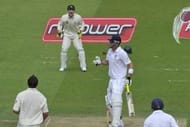It was during one of the most famous Test matches in Indian cricket history that it came to pass. At Chennai in March 2001, Australia were in control of the game with Matthew Hayden marching towards an impressive double hundred, Australia were looking imperious at 340-3.
Then it happened. The visiting captain Steve Waugh, having missed the ball while sweeping Harbhajan Singh, was alerted by Hayden that the ball may hit the stumps.
Having flown straight up in the air after making contact with Waugh’s leg, the ball then landed just outside the crease and spun towards the stumps with menace. Almost as a reflex, Waugh extended his arm and swatted the ball away to prevent it from hitting the stumps.
Bizarrely, despite his efforts to avoid dismissal, the Aussie skipper was, in fact, dismissed – given out for handling the ball.
He became the sixth batsman in Test cricket to be dismissed in this manner, and the eighth overall. His was one of the last such dismissals in the longest format of the game, and there have been nine unfortunate others like him – in all formats – in the near-140-year history of international cricket.
It remains one of the more unusual ways to be given out, but what does ‘handling the ball’ mean?
The letter of the law
Batsmanship, despite its bulky and fearsome gloves, is an art that is not remotely similar to goalkeeping. Both involve the use of gloves on the hands, but that is as far as the similarities go.
Except to avoid injury or to return the ball to the fielding side, the batsman should not touch the ball with his hands after playing a shit.
Interestingly, this guideline has been around since the very first laws of cricket were drafted in 1744. It has survived certain revisions since. Presently, it is governed by Law 33, which deals specifically with the act of handling the ball.
This law states very plainly that a batsman must be given out if, when facing a delivery bowled at them, he uses a hand which is not holding the bat to willfully hit, parry or otherwise make contact with it.
Much like the Waugh incident, this dismissal often occurs when a batsman is attempting to protect their stumps from a still-live ball that, after initially being bowled, threatens to hit their wicket. Batsmen have also used their legs or pads to achieve this purpose, but to do so with the hand is not permitted.
The batsman will be given out in case he is caught handling the ball. The bowler, however, is not credited with the wicket.
Handling the ball vs Obstructing the field
Returning the ball to the fielding side requires their consent; if a batsman were to do so without it, they would still be given out. This is under a separate offence of obstructing the field, since they are impeding the fielding side in some way.
Formerly, this meant they were out under Law 37 – which dealt with obstructing the field – but not under Law 33. It was then reverted to Law 33, but in 2013, returned to Law 37.
This move also made the distinction between the two modes of dismissal clearer. Simply put, before the striker has finished playing the ball, the charge of handling the ball applies.
A batsman is given out under Law 33 for handling the ball if they willfully make contact with a hand not holding the bat before they have finished playing it.
After they have finished playing it, on the other hand, they are given out under Law 37 for obstructing the field.
Famous incidents
The first batsman in international cricket to be dismissed in this manner was South Africa’s Russell Endean against England in 1957. In 1951, the famous Len Hutton became the only man in Test cricket so far to be given out for obstructing the field.
Under current rules, however, the dismissal would count as one of handling the ball. Interestingly, it was Endean himself who made the successful appeal that led to Hutton’s dismissal.
There have been a total of 61 such dismissals in first-class cricket and 5 in List-A cricket. In international cricket, this figure reads a round 10 – seven in Tests and three in ODIs.
Waugh’s dismissal is among the most famous of its kind. Others include Michael Vaughan, also against India in 2001 - the last man in Tests to be given out in such a fashion. Before him, there was another former England skipper – Graham Gooch against Australia in 1993, who swiped the ball away with his hand to be dismissed for 133.
Two of the most notable incidents have come in ODIs. In 1986, Mohinder Amarnath was given out this way against Australia in the second final of the World Series Cup. A ball from Greg Matthews would have hit his stumps had Amarnath not swiped it away at the last moment.
In 1999, Daryll Cullinan intervened with his hand when a slash at a Keith Arthurton delivery was making for his wicket.
Most recently, however, while batting against Afghanistan in October 2015, Zimbabwe’s Chamunorwa Chibhabha was given out for handling the ball – the first time in international cricket for 14 years. A delivery from spinner Amir Hamza was chopped dangerously close to his stumps: the batsman grabbed at it and tossed it away.
Mohammad Shahzad wasted no time in appealing from behind the stumps and Chibhabha was sent back to the pavilion.
Brand-new app in a brand-new avatar! Download CricRocket for fast cricket scores, rocket flicks, super notifications and much more! 🚀☄️

